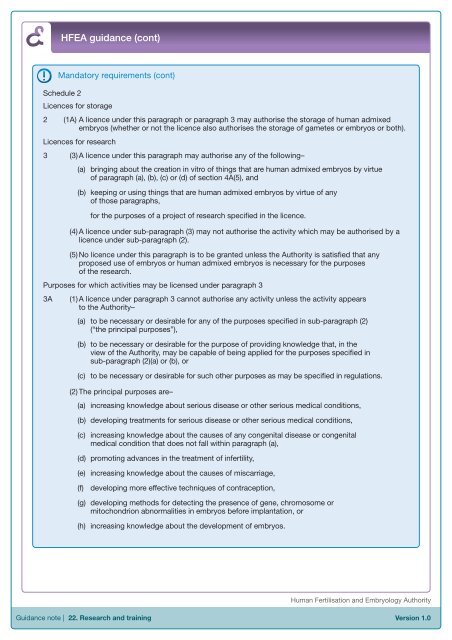Eighth Edition - R.3 - Human Fertilisation & Embryology Authority
Eighth Edition - R.3 - Human Fertilisation & Embryology Authority
Eighth Edition - R.3 - Human Fertilisation & Embryology Authority
You also want an ePaper? Increase the reach of your titles
YUMPU automatically turns print PDFs into web optimized ePapers that Google loves.
HFEA guidance (cont)<br />
Mandatory requirements (cont)<br />
Schedule 2<br />
Licences for storage<br />
2 (1A) A licence under this paragraph or paragraph 3 may authorise the storage of human admixed<br />
embryos (whether or not the licence also authorises the storage of gametes or embryos or both).<br />
Licences for research<br />
3 (3) A licence under this paragraph may authorise any of the following–<br />
(a) bringing about the creation in vitro of things that are human admixed embryos by virtue<br />
of paragraph (a), (b), (c) or (d) of section 4A(5), and<br />
(b)<br />
keeping or using things that are human admixed embryos by virtue of any<br />
of those paragraphs,<br />
for the purposes of a project of research specified in the licence.<br />
(4) A licence under sub-paragraph (3) may not authorise the activity which may be authorised by a<br />
licence under sub-paragraph (2).<br />
(5) No licence under this paragraph is to be granted unless the <strong>Authority</strong> is satisfied that any<br />
proposed use of embryos or human admixed embryos is necessary for the purposes<br />
of the research.<br />
Purposes for which activities may be licensed under paragraph 3<br />
3A<br />
(1) A licence under paragraph 3 cannot authorise any activity unless the activity appears<br />
to the <strong>Authority</strong>–<br />
(a) to be necessary or desirable for any of the purposes specified in sub-paragraph (2)<br />
(“the principal purposes”),<br />
(b) to be necessary or desirable for the purpose of providing knowledge that, in the<br />
view of the <strong>Authority</strong>, may be capable of being applied for the purposes specified in<br />
sub-paragraph (2)(a) or (b), or<br />
(c)<br />
to be necessary or desirable for such other purposes as may be specified in regulations.<br />
(2) The principal purposes are–<br />
(a) increasing knowledge about serious disease or other serious medical conditions,<br />
(b)<br />
(c)<br />
(d)<br />
(e)<br />
(f)<br />
(g)<br />
(h)<br />
developing treatments for serious disease or other serious medical conditions,<br />
increasing knowledge about the causes of any congenital disease or congenital<br />
medical condition that does not fall within paragraph (a),<br />
promoting advances in the treatment of infertility,<br />
increasing knowledge about the causes of miscarriage,<br />
developing more effective techniques of contraception,<br />
developing methods for detecting the presence of gene, chromosome or<br />
mitochondrion abnormalities in embryos before implantation, or<br />
increasing knowledge about the development of embryos.<br />
<strong>Human</strong> <strong>Fertilisation</strong> and <strong>Embryology</strong> <strong>Authority</strong><br />
Guidance note | 22. Research and training<br />
Version 1.0

















